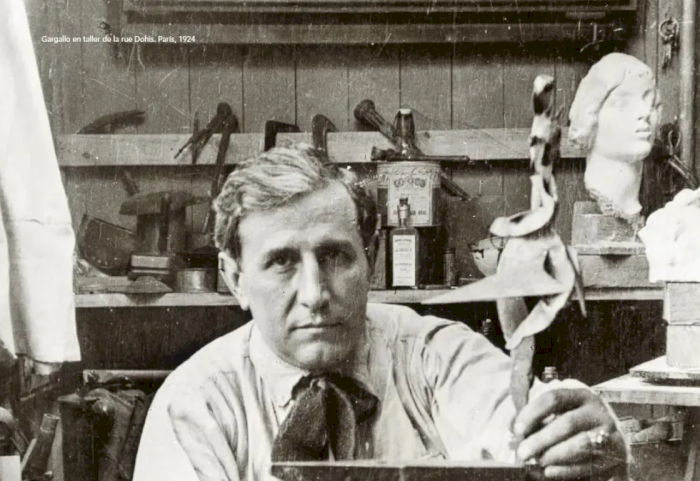Pablo Gargallo (1881-1934)
Maella (Spain), 5 January 1881 - Reus, 28 December 1934
Born into a modest family in Maella (a municipality in the province of Zaragoza in Aragon), Pablo Gargallo y Catalán moved with his family to Barcelona in 1888. At the age of 14, he became an apprentice to the sculptor Eusebi Arnau, learning stone-cutting, moulding, fine-tuning and enlarging models. At the same time, in 1897, he entered the La Lonja School of Fine Arts, where he was influenced by his teacher, the ‘noucentisme’ sculptor Agapit Vallmitjana.
At the turn of the XXᵉ century, he made friends with the artists who frequented the café Els Quatre Gats: Pablo Picasso, Isidre Nonell, Manolo Hugué, among others... Having obtained a scholarship, he went to Paris in 1903 where he settled in an artists' housing estate, rue Vercingétorix, in the XIVth arrondissement. There he discovered the work of Rodin.
Back in Barcelona, he set up his own studio and worked with the leading figures in Catalan modernism: the architect Luis Domènech i Montaner commissioned him to sculpt the decor for the Hospital de la Santa Creu i Sant Pau. From 1906 to 1911, he worked on this commission with the studio of the sculptor Eusebi Arnau, creating some thirty monumental sculptures and a large number of bas-reliefs. Between 1908 and 1909 he worked with Eusebi Arnau on another commission from Domènech i Montaner for the interior decoration of the Palau de la Música Catalana in Barcelona.
In 1907, he made another trip to Paris. He stayed with Picasso at the Bateau Lavoir and discovered Les Demoiselles d'Avignon. He then moved to rue de Sèvres and worked for the sculptor Robert Wlérick, where he made his first metal mask. From then on, working with copper and iron, he invented ‘cut-out’ sculpture: thin sheets of metal welded or riveted together, creating volumes that play on fullness and emptiness. During this stay, he met Manolo Hugué and Max Jacob again, and forged a lasting friendship with Juan Gris.
He continued to work on commissions in Barcelona. For the façade of the Théâtre Bosc, he created four bas-relief portraits of Picasso, Nonell and Reventòs, and a self-portrait.
In 1912, he returned to Paris, immersed himself in Cubism without making it his own, and engaged in dialogue with Picasso and Gris. He created portraits, masks and sculptures in metal, demonstrating great dexterity in working with this material. He made friends with many of the leading figures of Parisian bohemia. In 1915, he married Magali Tartanson. During the war, the couple moved to Barcelona.
In 1920, he was appointed professor of sculpture and repoussé at the Escuela Técnica de Oficios de Arte de la Mancomunidad de Cataluña. That same year, he also obtained a post as professor of sculpture at the Escuela Superior de Bellos Oficios. It was here that Gargallo met the ceramist Josep Llorens i Artigas, who was to become one of his most loyal friends. During this period, he explored the possibilities of lead and discovered the ‘hollow form’, an inversion of volumes and a totally original invention that would be used in many future creations. His only daughter, Pierrette, was born in 1922. Gargallo was already suffering from serious lung problems.
Returning to Paris in 1924, he set up home in Vincennes and introduced a new creative process by making cardboard patterns for his metal cut-outs, enabling him to make several copies of a model.
Among Pablo Gargallo's major works, The Prophet (1933) occupies a central place. Made in wrought iron, this upright figure, with its arm stretched towards the sky, presents a striking synthesis of the void and the solid. Similarly, The Great Boxer (1931) embodies Gargallo's fascination with the male body, both athletic and stylised. The artist also explored mythological or symbolic figures with Uranus and Pegasus (1933), a winged horse carrying a human figure. His Masks, which he began in the 1910s, are another essential dimension of his work. Through a simple combination of metal planes, he condenses the expression of a face, sometimes reduced to an eye, a nose or a mouth, as in Masque de Kiki de Montparnasse.
Through these works, Pablo Gargallo develops a profoundly innovative sculptural vocabulary, in which biblical, mythological, athletic or poetic figures become the medium for a plastic investigation of light, movement, space and balance. A pioneer of cut-out iron sculpture, he paved the way for many artists such as Julio González (whom he preceded), Pablo Picasso, Henry Moore, David Smith, Anthony Caro...
Alongside his formal research, Gargallo remained faithful to classicism: marbles, bronzes and terracottas punctuated his career, revealing a versatility in which ideal beauty was combined with avant-garde experimentation.
He exhibited regularly at the Salon des Indépendants and the Salon des Tuileries, as well as at the Georges Bernheim gallery in Paris and the Alfred Fleichtheim gallery in Berlin. From 1929, iron became his favourite material.
In 1934, two major solo exhibitions were held at the Brummer Gallery in New York and the Sala Parés in Barcelona. But weakened by lung problems, he died suddenly in Reus at the age of fifty-three as Spain was plunged into the terrible Civil War.
Today, his work can be seen at the Pablo Gargallo Museum (Zaragoza, Palacio Torrero since 1985), as well as in Maella, in the house where he was born.
